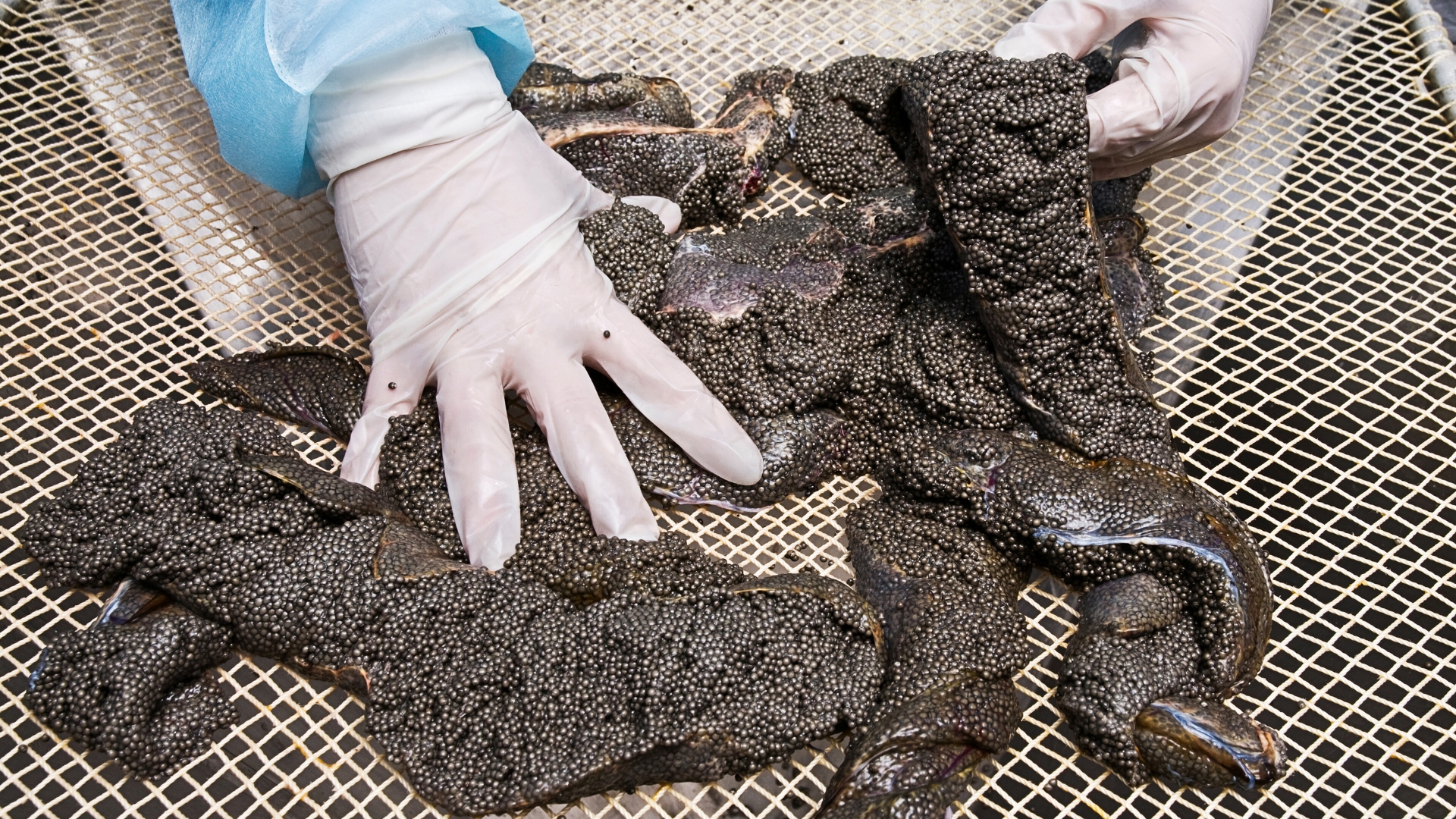Sturgeon caviar is considered a culinary delicacy and is consumed by native cultural traditions. However, the impact of sturgeon fish caviar commercialization has significantly contributed to its critically endangered status due to overharvesting, unsustainable farming practices, and the illegal caviar trade.
With two-thirds of the sturgeon population on the brink of extinction and one species confirmed extinct, we must transform how they’re commercialized or risk disrupting freshwater ecosystems.
Learn how businesses use sturgeon for caviar, why it’s in high demand, and how we can reform public consumption to protect them.
Sturgeon Caviar: Why It’s a Sought-After Commodity
A sturgeon is a pre-historic freshwater fish species found in lakes, rivers, and seas throughout the world. Sturgeon fish eggs are commonly harvested to create caviar and meat and are considered a high-end commodity in the culinary industry.
Sturgeon caviar is sought after because they’re scarce to come by due to wildlife conservation law restrictions, declining populations, and lengthy breeding seasons. Depending on the species, female sturgeon fish take between 8 to 17 years to mature and spawn. Due to limited availability, sturgeon have become exploited and endangered in the seafood trade market.
Why Sturgeon Caviar Harvesting Needs Reform to Protect This Endangered Species

Current sturgeon caviar harvesting practices aren’t sustainable and in some areas, illegal. Even with wildlife conservation laws and government regulations, they still need modernization, as poaching and overfishing are still significant issues.
While there are legislation efforts, more standards need to be implemented in the commercialization of sturgeon for sustainable farming and efficient raising of captive-bred sturgeon. Government agencies are currently facing challenges in protecting wildlife sturgeon without destroying captive-bred farms.
That’s why, now more than ever, we must reform current aquaculture policies to strengthen the ethical and sustainable practices in the caviar industry.
Unsustainable Sturgeon Caviar Harvesting Practices
The sturgeon caviar market is overfishing and isn’t stocking enough fish back into the wild or utilizing captive breeding to preserve wild habitats due to high production costs. In fact, sturgeon caviar production nearly doubled from 265 to 516 metric tons from 2015 to 2020.
Sturgeon farmers must meet stock output requirements with the amount of fish they remove from the wild to reduce population declines. They must also invest in long-term captive breeding facilities where sturgeon can adequately breed for years before harvesting their eggs and meat.
Sturgeon farm requirements must also include government permits and licenses to ensure their caviar production processes are compliant. These practices will help conserve sturgeon and ensure their commodities don’t become extinct.
Sturgeon Play a Crucial Role in the Ecosystem
Sturgeons play a vital role in freshwater ecosystems. They feed on decaying organisms and invasive species, which is crucial to maintaining the balance of the ecological food chain. Without sturgeon, the quality of our lakes, rivers, and seas will become compromised, along with endangering other aquaculture species that help sustain global communities.
Sturgeon Are Endangered Pre-Historic Species
Did you know that sturgeon fish have been around since the dinosaur era? As a pre-historic species that survived mass extinction during that period, it would be a historic loss to lose them from human-related causes. Depending on the species, they can even live up to 100 years.
Sturgeon Caviar FAQs

What’s the Difference Between Sturgeon Caviar vs. Sturgeon Roe?
Like caviar, roe are fish eggs. However, caviar is a type of fish roe. Sturgeon doesn’t have roe, only caviar.
How Much is Sturgeon Caviar?
Depending on the species, sturgeon caviar prices range from $50 to $75 per ounce at the lowest but are commonly found at $100 and more.
Is Caviar Only From Sturgeon?
Caviar typically refers to sturgeon. Fish roe are also harvested from other fish, including trout, salmon, and carp.
Do People Eat Sturgeon?
Yes, sturgeon caviar is widely consumed, along with certain native cultures.
What Does Sturgeon Taste Like?
Consumers and native cultures state that sturgeon has a salty and earthy flavor. However, there are plenty of substitutes available to reduce sturgeon overconsumption. Sturgeon caviar alternatives include salmon, snail, trout, and whitefish caviar. Couscous is also a vegan caviar substitute.
Is Sturgeon Good to Eat?
Historic native cultures, like the Menominee people, consume sturgeon meat and caviar as part of their traditional cuisine. It’s not recommended currently for public consumption due to unsustainable commercialization practices.
Support Sturgeon Conservation With SIAA
At the Sturgeon Industry Alliance of America (SIAA), our mission is to conserve captive and wild sturgeon populations, along with other species that can be affected by aquaculture regulations. We even help sturgeon farms improve their production processes with sustainable practices to preserve this vital species and reduce their endangerment.
Our conservation strategies integrate scientific research on captive-bred sturgeon and educational-conscious consumption to promote long-lasting change. Whether you’re in the fish production trade or passionate about wildlife conservation, anyone can become involved and make a difference.
Donate to SIAA or join the fight to protect sturgeons by becoming a member today!





